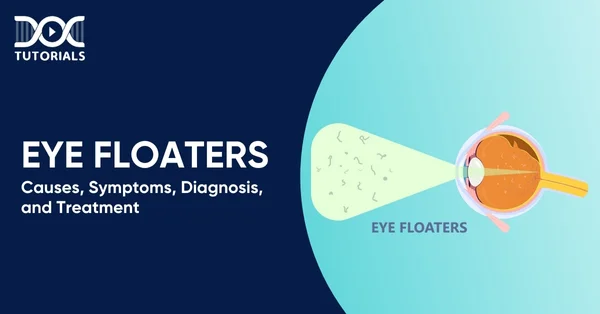Eye Floaters: Causes, Symptoms, Diagnosis, and Treatment

Eye floaters are elusive threads, specks, or cobweb-like forms that float through your eyesight. They usually manifest themselves when looking at a bright background, such as a white wall or a blue sky.
While they can be bothersome at times, it is crucial to understand their causes and recognise when they might signify a more serious issue. For students of medicine who are appearing for exams such as NEET PG, understanding the fundamentals of such health conditions is necessary.
DocTutorials provides thorough study material that demystifies such concepts, helping students master subjects such as eye floaters with lucidity and confidence.
What are Eye Floaters?
Eye floaters are tiny specks, strands, or web-like shadows that float in your line of sight. These effects are most noticeable when observing an object set against a bright background, like a clear sky or a white wall. Floaters are created by small collections of collagen within the vitreous gel in the eye, casting shadows on the retina.
Though they can be irritating, they do not generally affect vision and are usually benign. Floaters increase with age, and though they do not disappear, most people eventually become accustomed to them and even begin to pay less attention to them over time. Large floaters occasionally cast shadows or necessitate medical care.
What are the Symptoms of Eye Floaters?
Eye floaters are visual phenomena that may be changeable in form and movement. Although generally harmless, knowing their symptoms assists in separating normal changes of ageing from more serious eye conditions. They include:
- Black or grey specks that move through your eye
- Thread-like fibres, curly lines, or ‘worms’ that track as your eyes move
- Shadows resembling cobwebs or clouds are especially observed when set against light backgrounds
- Spider or amoeba forms that change location as your eyes move
- Spots or blobs that appear to move away or float when you attempt to look at them directly
- Dark shadowy rings or circles in your periphery or central vision
- Flashes of light (photopsias), which can be associated with floaters, particularly with posterior vitreous detachment
- Perception of movement, where floaters appear to drift or move with your eye movements
- Increased visibility under bright light, such as when viewing the sky or a white surface
What are the Causes of Eye Floaters?
Eye floaters are most often caused by age-related changes in the vitreous, the gel that fills the eye. With age, the collagen fibres in the vitreous shrink and clump together, casting shadows on the retina and creating floaters.
Although usually harmless, floaters can sometimes point to serious conditions such as retinal tear or detachment, particularly if accompanied by flashes of light. Less frequent reasons are inflammation of the eye (such as uveitis), bleeding within the eye due to diabetic retinopathy, eye trauma, or tumours. Drastic changes in floaters necessitate immediate medical care.
Risk Factors of Eye Floaters
There are various risk factors for developing floaters in the eyes. They include:
- Ageing, especially after the age of 50
- Family history of retinal tears or detachment
- Being myopic (near-sightedness), which raises the risk of vitreous degeneration
- Past history of uveitis, an inflammatory eye disease
- Past eye operations, particularly the removal of the cataract
- Diabetes, which in turn causes diabetic retinopathy
- Autoimmune infections or diseases, which can result in inflammation of the eye
- Eye injury or trauma
- The existence of eye tumours or crystal-like formations in the vitreous
Diagnosis of Eye Floaters
Physicians will start asking the patient about the symptoms, including when the floaters appeared and any changes in vision.
- Eye Examination: A thorough eye exam will be performed to determine your overall eye health.
- Pupil Dilation: The provider will dilate your pupils to get a clear view of the vitreous humour and retina.
- Retinal Test: The retina is going to be inspected thoroughly to see if any tears, detachments, inflammation, or infections are the reason for the floaters.
- Monitoring: Regular eye exams might be suggested to monitor changes in the vitreous over time and avoid complications.
Medical Treatment Options for Eye Floaters
Eye floaters treatments vary based on symptoms and severity. Here are the major medical treatments adopted to deal with this ailment:
- Laser Treatment
In mild floaters, ophthalmologists can apply laser treatment to shatter the clumps in the vitreous humour. A unique laser, which resembles the one used in Laser-Assisted In Situ Keratomileusis (LASIK), hits and spreads the floaters, rendering them less visible.
Improvement is reported in some patients, but results are unpredictable, and a low risk of retinal damage exists if the laser is not accurately directed. However, more studies are required to ensure the safety and efficacy of this treatment.
- Vitrectomy
In more extreme cases where floaters are severely restricting vision, a vitrectomy is considered. Through a surgical procedure, the vitreous gel holding the floaters is removed, and a saline solution or a gas/oil bubble is inserted in its place.
The eye gradually fills the space with its own natural fluids over time. Although effective, vitrectomy poses risks, including infection, retinal detachment, or cataracts, and is normally reserved for extreme situations.
Natural Treatment Approaches to Manage Eye Floaters
If the eye floaters are minor, natural methods may diminish their effect or enhance overall eye health:
- Eye Movement: Slowly rolling the eyes upward and downward moves the vitreous fluid and may relocate floaters out of your direct line of vision.
- Balanced Diet: Vitamin A, omega-3, and antioxidant-rich foods such as leafy greens, carrots, fish, and dairy products promote eye functioning.
- Supplements: Vitamin A, zinc, and omega-3 fatty acid supplements may support healthy eyes.
- Avoiding Eye Strain: Limit screen time, take frequent breaks, and adjust lighting to lessen visual stress.
- Lifestyle Modifications: Stop smoking, wear sunglasses outside, use soft lighting inside, and drink plenty of water to ensure vitreous consistency.
- Distraction strategies: Practice walking, dancing, or playing games to divert attention and minimise the distraction caused by floaters.
FAQs About Eye Floaters
- What are the types of eye floaters?
Eye floaters develop in four sizes and shapes: dark or grey dots, threadlike strands, which can be knobby and transparent, cobwebs, wavy lines, rings, and so on.
- How long do the eye floaters last?
For some people, floaters in the eyes can resolve in weeks. For others, it can take months. The type and severity of eye floaters determine everything, and there may be other factors that can make them more noticeable or persistent, like retinal detachment or diabetic retinopathy.
- Do eye exercises help get rid of my floaters?
Yes, performing certain eye exercises can help strengthen the muscles in your eyes and improve your vision. They may also help manage and minimise the symptoms of flashes and floaters.
- Can floaters be caused by dehydration or lack of water?
Yes, dehydration can cause eye floaters due to the fluid composition of the vitreous humour, which is made up of 98% water. Dehydration can cause the vitreous to shrink, causing the proteins to cluster together, which can lead to more noticeable eye floaters in your field of vision.
- Can age-related eye floaters be prevented?
In general, people cannot prevent age-related eye floaters, but you can decrease the risk of such ailments by managing chronic conditions, such as diabetes and high blood pressure (hypertension).
Conclusion
Eye floaters are a frequent phenomenon, particularly with age, and are usually a benign aspect of the ageing process. Yet, knowing their causes, identifying related symptoms, and knowing when to visit a doctor is essential for healthy eyes. To help medical students with their NEET PG exam preparation, DocTutorials offers study materials that explain complex health conditions, such as eye floaters, in detail, making them easier to understand and study. Awareness of eye health and regular eye check-ups can assist in the early diagnosis and treatment of possible eye problems.
Latest Blogs
-

NEET PG Syllabus 2025: A Must-Have Complete Guide for Exam Success
The NEET PG Syllabus acts as one of the foundation stones for aspiring postgraduate medical students like you who are…
-

FMGE Exam Preparation with Our FMGE 2025 Vijeta Online Live Plan
FMGE (Foreign Medical Graduate Examination) 2025 is going to be daunting for multiple factors. But with the right tools and…
-

NEET PG Exam 2025- Date, Pattern, Marking Scheme, Subject Wise Weightage, and Exam Mode
NEET PG Exam 2025 is the ultimate gateway for medical graduates aspiring to pursue postgraduate courses in medicine, including MD,…




